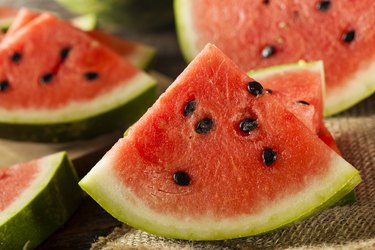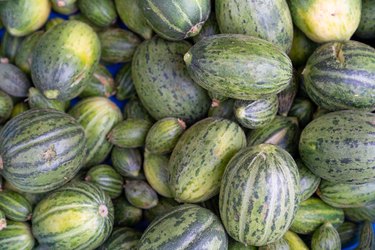If a perfect summer afternoon could be captured in a single image, that image might just be a stack of watermelon rinds left over at the side of a picnic table. Crisp, juicy watermelon is a perfect summer treat – cool, refreshing and hydrating – but the rinds left behind after eating watermelon are underappreciated. You may have grown up eating pickled watermelon rinds as an old-fashioned treat, but they have many uses (some rather surprising) aside from the traditional pickles. Here's a handful you may have never even considered.

Video of the Day
Why You Should Be Using Watermelon Rinds
You're probably wondering why you would bother using the part everyone else throws away, and that's fair. There are actually several reasons once you start digging. One is sustainability: According to the National Watermelon Promotion Board, using the whole watermelon (i.e., a full-size, standard watermelon) can save a full 5 pounds of food waste from going to the landfill. A second reason is simple frugality. You've paid for the melon; why would you not want to get the maximum return on your investment?
Video of the Day
More importantly, watermelon rind packs a surprising nutritional punch. It contains carotenes that your body will turn into vitamin A as well as vitamin C, potassium, magnesium and several of the B vitamins. It also packs a lot more fiber than the pink flesh, and fiber contributes to gut health and general health in several ways (including lowering your cholesterol and helping stabilize blood sugar levels). A more intriguing component is an amino acid called citrulline, which some studies suggest can improve heart health, lower blood pressure and protect against atherosclerosis. It may also help improve fitness and athletic performance, and if that's not enough, it's also a potent antioxidant.
Finally, if the health benefits aren't enough to persuade you to eat watermelon rind, there's one more reason: Watermelon rind is simply a fun, versatile and flavorful ingredient to play with in the kitchen. So, let's dig in, shall we?

Culinary Uses for Watermelon Rinds
The next time you eat a slice of watermelon, use a vegetable peeler or paring knife to peel away the tough green skin and then take a bite of the white part of the rind. It has a crisp, cool character that's reminiscent of cucumber, but it's dense and firm and has a faint, refreshing tang as well. In other words, it's an ingredient that brings a lot to the table.
So, how can you use them? Here's a quick selection of ideas to get you started.
- Julienne them as a sandwich ingredient: Peel your rinds with a vegetable peeler and then cut them into matchsticks with a sharp knife or mandoline slicer. The rinds add moisture and crunch to your favorite sandwich without overpowering the flavors that are already there. Alternatively, you can use them to fill Vietnamese-style rice paper rolls or summer rolls along with shredded carrots or daikon.
- Add them to your salads: Julienned, cubed or thin-sliced watermelon rinds make a fine addition to salads as well. (Cut them to a shape that's appropriate for your salad.) Try a combination of watermelon rind with fennel and apple or use it in place of or along with cucumber in a Greek salad. It's good in a fruit salad as well, especially when you need a bit of crunch to balance out softer ingredients, such as berries.
- Quick-pickle them: Instead of making conventional full-size pickles from the rinds, quick-pickle them (as you would with carrots, daikon or other vegetables) by pouring a hot vinegar-based brine over your sliced or julienned rinds. You can use them in as little as an hour, though the flavor will deepen with more time in the fridge. Add spices and herbs for different flavor variations (ginger, garlic and chilies, for example) or experiment with apple cider vinegar vs. wine vinegar vs. rice vinegar to see which you like best.
- Use them as a cucumber substitute: Watermelon rinds make a fine substitute for cucumbers in tzatziki or a complement to your cukes if you need to make an extra-large batch. They're also an excellent alternative to cucumbers in gazpacho, where you can use them along with other high-summer ingredients, like fresh bell peppers and tomatoes (ideally from your own garden).
- Grill your rinds: Brush the rinds with a flavorful marinade and then char them on your grill until tender-crisp. They're a surprisingly tasty side vegetable, and they go great with rich pork and other meats.
- Toss them into stir-fries: Like sweet peppers, watermelon rind adds some welcome moisture and crunch to stir-fried dishes.
- Preserve them: You can make watermelon rinds the star of their own flavorful chutney or a key ingredient in your homemade kimchi. You can use them in pretty much any recipe for a homemade relish or preserve as a substitute for cucumbers (and they'll stay crunchy longer).
That's just the tip of the iceberg. The National Watermelon Promotion Board has an entire section just for rind recipes, so you can explore to your heart's content.
Tip
While we’re on the subject of food waste, don’t sleep on the watermelon seeds either. They can be roasted like pumpkin seeds and then eaten as a snack or used as a garnish for salads and baked goods. Roasted seeds can be round up to make a “nut” butter as well if your blender is up to the task (or if you have a mortar and pestle and you’re in the mood for a workout).
Alternatively, you can sprout them and eat them in salads and sandwiches or pulse them in your food processor and add them to homemade energy bars.

Beverage Uses for Watermelon Rinds
Along with the rinds' uses on your plate, there are also several ways to add them to beverages.
- Juice your rinds: Just drop the rinds into your juicer as you would with any other vegetable. Leave the skin on for a green-hued juice or peel it for one that's relatively colorless. If you don't have a juicer, you can process the rinds in a high-speed blender or food processor or simply grate them and then squeeze the pulp in a cheesecloth or fabric bag to extract the juice. Drink it well chilled as is or use it in your favorite smoothie, protein shake or cocktail.
- Freeze cubes of rind: There are two ways to do this. For a punch bowl, freeze chunks of melon rind and add them to your bowl instead of (or along with) conventional ice cubes. Alternatively, you can puree the watermelon rinds with or without the green peel (a high-powered blender is your best bet if you want them with the peel) and freeze the pulp in ice cube trays. When you make your next smoothie, drop in a handful of cubes along with the ice to add a subtle cucumber flavor.
- Peel ribbons of rind: Use your vegetable peeler to take long, thin strips from the side of your rinds and add them to your pitcher of lemonade. Like cucumbers, they add a subtly refreshing note that doesn't take away from the tang of the lemons.
Nonculinary Uses for Watermelon Rinds
Watermelon rinds' unexpected nutritional value notwithstanding, there's no rule that says you need to eat or drink them. Nonculinary watermelon rind hacks include:
- Using rinds as a soothing cold compress: Remember the old tip of putting cucumber slices on your eyes as a soothing "spa day" moment? Thin slices of watermelon rind work just as well, and you can cut them to just about any size and shape you want. They're also good for scenarios like soothing a mild burn. They won't help it heal, but it'll feel good in the short term.
- Compost them: If you have a garden, composting your rinds is one additional way to keep them out of the landfill. You can add them directly to your pile like the scraps from other veggies, but they'll decompose more quickly if you chop them coarsely or shred them first. The moisture they bring to your pile helps keep it active, especially if you're in an area where water use is restricted in summertime. Alternatively, if you compost with worms (vermicomposting), slices of watermelon rind will help keep your little wrigglers very happy indeed.
- Using mini-melon rinds as planters: The best rinds for culinary purposes come from the biggest melons, but what if you prefer mini melons? Well, a halved mini watermelon makes a perfectly biodegradable starter pot for your garden transplants. Poke a few holes in the bottom for drainage (and an exit point for plants' roots), fill it with potting soil and set it on a small saucer to keep it from leaking onto your counter or windowsill. Plant flower or vegetable seeds in it (opt for plants with quick germination) and wait for your seedlings to pop up. Once they're well established and the outdoor temperature is suitable, transplant them rind and all into your garden. The rind will break down over the course of the summer, giving up its moisture and nutrients to your plants. This works with other melon rinds (cantaloupes, small honeydews, etc.) as well.

So, the next time you buy a watermelon, don't just toss the rinds. Try one of our suggestions – or create your own! – and then give yourself a pat on the back for helping reduce food waste.
- Nutrients: L-Citrulline Supplementation: Impact on Cardiometabolic Health
- Journal of Strength and Conditioning Research: Effects of Citrulline Supplementation on Exercise Performance in Humans: A Review of the Current Literature
- National Watermelon Promotion Board: Rind Recipes
- National Watermelon Promotion Board: Use the Whole Watermelon